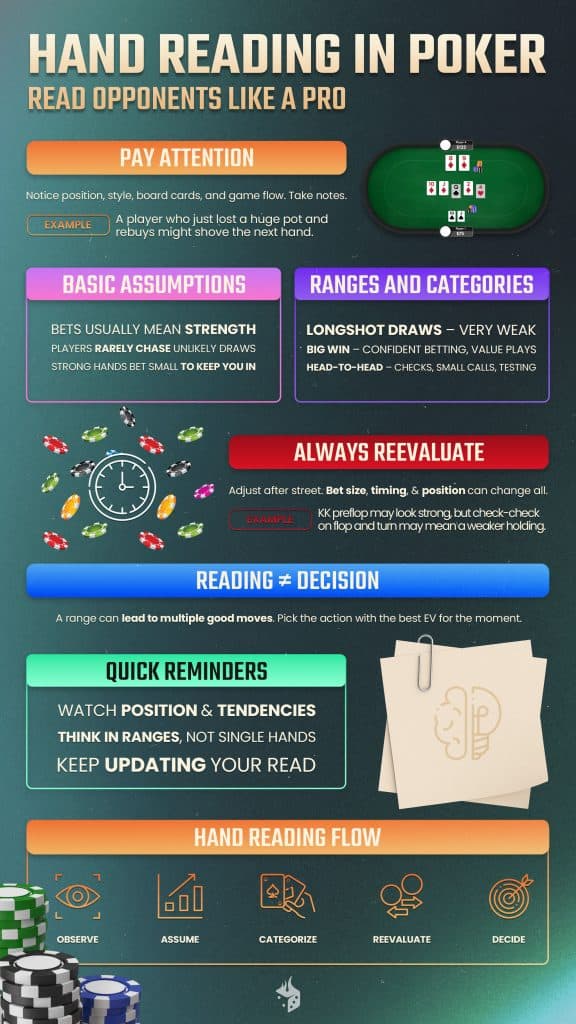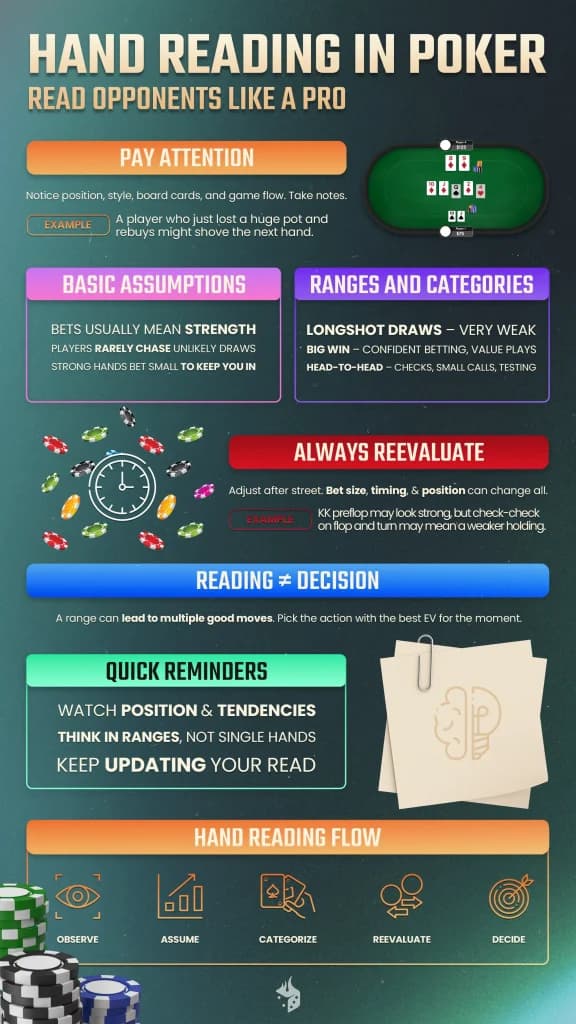
One of the most mystifying parts of playing poker is guessing what your opponent has. And because each player can be quite tricky, the skill takes a lot of time to develop. Get it wrong and you could get stacked after a single mistake. Get it right and you could get paid handsomely.
So, how do you read opponents’ hands when you’re playing online poker? There’s fewer tells than at a live game, so you’ll need a reliable way to think about what other players have. Let’s get into some valuable tips you can use in your very next game.

Pay Attention
Good hand reading starts by paying attention to everything. Opponent position, tendencies, the cards on the board, the vibe of the game – it all can have an effect on your opponents’ hand ranges.
Let’s say you’re playing a splashy game where everyone is getting in on family pots and then betting and raising each other. Should you try a bluff? Probably not. People have opened up their ranges and are not looking to play timidly and lay down even marginal hands in these situations.
What about a situation where a player has been folding for 20 minutes and then raises you preflop while sitting to your left? Are they trying to bully you, or do they have it? They have more AA, KK, and QQ in their range, based on their playstyle. That said, their position opens this range a tad, as does the fact that they’ve folded a lot. Maybe they are getting impatient and are raising with TT or even JTs? Think of the first set of hands as “Range A” and the second set as “Range B.”
Nothing is irrelevant. Take notes on opponents. Be a sponge for information at your table if you want to really read your opponents. (And by the way, that player who just lost a massive pot and rebought immediately is ready to go berserk on his/her next hand. Be ready for an all-in.)

Basic Assumptions
When it comes to reading poker hands, there are some assumptions that will hold true most of the time. These apply to all blind levels and game types, but only as general guidelines.
- Players usually bet with strong hands. Most of the time, a bet is an indication of strength. Of course, bluffing is a thing. But it should not be your first thought. Take bets at face value until enough factors point in favor of a bluff for you to change your analysis.
- Players usually won’t overbet with strong hands. This point follows from the first one. Players don’t want to push you out of the pot with strong hands. They want you to stick around and pay them. For this reason, opponents will often use a bet size that encourages you to stay in the hand if they have the goods.
- Players usually won’t chase long-shot draws. Players are rarely sticking around in pots when they have no real chance of making a hand. Don’t put opponents on hands that the odds calculator says are nearly worthless. It will happen every now and then, but don’t let it throw you off your hand reading.
Ranges and Categories
While thinking about ranges of hands to put opponents on, it can be helpful to use these basic categories:
- Big win hands. Players with big hands often play and bet with confidence. Take these players at their word unless you’re seeing signs that they are bluffing (they seem to want everyone out of the pot, they are overbetting in late position, etc.).
- Head-to-head hands. Players with these hands won’t try to build pot. They put in checks and will make calls when necessary. They may bet small as a test. Opponents in this range are not making big moves at all.
- Longshot drawing hands. We’re not talking about semi-bluff hands, but true longshot hands. The only way for these hands to win is to push others out. They have almost no showdown value. The players may not be willing to do this, and so hands like these play in a polarizing way: either extremely weak or overly aggressive. There’s not much in between.
Remember: it’s about ranges, not exact hands. We have a few possibilities for what opponents are holding, and we don’t get too committed to one interpretation. Speaking of which…
Always Reevaluate
Actions change things in a poker hand. A player’s preflop image might have been super strong, but they may have checked on the flop and turn. Do you apply the same interpretation, or do you change it? You have to update your understanding. What seemed like KK or QQ due to preflop re-raises might smell more like TT or KQs after the turn is done and the aggression is nowhere to be seen.
Consider how long it takes the player to make decisions, the size of their bets, and their position after each round of betting. Don’t let them buy an image early on and lock it in for the whole hand. Likewise, don’t let early passivity trick you into disbelieving the huge bets on the turn and river on a dry board. They didn’t necessarily wake up with a hand; they might have been slowplaying those pocket rockets or flopped set all along. Keep processing new information and make decisions in real time.

Knowing Range ≠ Knowing Right Move
Knowing what cards your opponent probably has doesn’t always mean you know the right move. Some ranges will have you very spread out among possible actions. There are plenty of hands where arguments could be made for raising and folding. Make sure that your strategy is ready to work with ranges that straddle multiple actions. The opponents’ likely holdings don’t lead directly to a perfect strategy, or poker would be completely solved already.
You’ve got to work with some uncertainty and make decisions that are at least arguably correct. You should be able to explain why you did what you did and have it make sense after the hand is over. If you can’t, it’s a good exercise to do regularly to help train this part of your mind and turn yourself into a skilled poker hand reader.



